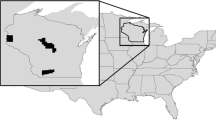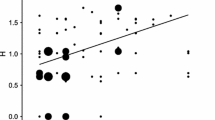Abstract
Fragmentation of grasslands has been implicated in grassland bird population declines. Multi-scale models are being increasingly used to assess potential factors that influence grassland bird presence, abundance, and productivity. However, studies rarely assess fragmentation metrics, and seldom evaluate more than two scales or interactions among scales. We evaluated the relative importance of characteristics at multiple scales to patterns in relative abundance of Savannah Sparrow (Passerculus sandwichensis), Grasshopper Sparrow (Ammodramus savannarum), Eastern Meadowlark (Sturnella magna), and Bobolink (Dolichonyx oryzivorus). We surveyed birds in 74 southwestern Wisconsin pastures from 1997 to 1999 and compared models with explanatory variables from multiple scales: within-patch vegetation structure (microhabitat), patch (macrohabitat), and three landscape extents. We also examined interactions between macrohabitat and landscape factors. Core area of pastures was an important predictor of relative abundance, and composition of the landscape was more important than configuration. Relative abundance was frequently higher in pastures with more core area and in landscapes with more grassland and less wooded area. The direction and strength of the effect of core pasture size on relative abundance changed depending on amount of wooded area in the landscape. Relative abundance of grassland birds was associated with landscape variables more frequently at the 1200-m scale than at smaller scales. To develop better predictive models, parameters at multiple scales and their interactive effects should be included, and results should be evaluated in the context of microhabitat variability, landscape composition, and fragmentation in the study area.

Similar content being viewed by others
References
Andren H (1994) Effects of habitat fragmentation on birds and mammals in landscapes with different proportions of suitable habitat: a review. Oikos 71:355–366
Bakker KK, Naugle DE, Higgins KF (2002) Incorporating landscape attributes into models for migratory grassland bird conservation. Conserv Biol 16:1638–1646
Best LB, Bergin TM, Freemark KE (2001) Influence of landscape composition on bird use of rowcrop fields. J Wildl Manage 65:442–449
Bissonette JA, Storch I (eds) (2003) Landscape ecology and resource management: linking theory with practice. Island Press, Washington
Bollinger EK, Gavin TA (1989) The effects of site quality on breeding-site fidelity in Bobolinks. Auk 106:584–594
Bollinger EK, Gavin TA (1992) Eastern Bobolink populations: ecology and conservation in an agricultural landscape. In: Hagan III JM, Johnston DW (eds) Ecology and conservation of neotropical landbirds. Smithsonian Institute Press, Washington, pp 497–506
Burnham KP, Anderson DR (2002) Model selection and multimodel inference, a practical information-theoretic approach, 2nd edn. Springer-Verlag, New York
Chalfoun AD, Thompson FR, Ratnaswamy RJ (2002) Nest predators and fragmentation: a review and meta-analysis. Conserv Biol 16:306–318
Collins SL, Glenn SM (1995) Landscape ecosystem and landscape dynamics. In: Joern A, Keeler KH (eds) The changing prairie. Oxford University Press, Oxford, pp 128–156
Coppedge BR, Engle DM, Masters RE, Gregory MS (2001) Avian response to landscape change in fragmented southern Great Plains grasslands. Ecol Appl 11:47–59
Cressie NAC (1993) Statistics for spatial data, revised edn. John Wiley and Sons, New York
Cunningham MA, Johnson DH (2006) Proximate and landscape factors influence grassland bird distribution. Ecol Appl 16:1062–1075
Daubenmire R (1968) Plant communities: a textbook of plant synecology. Harper and Rowe, New York
Davis SK (2004) Area sensitivity in grassland passerines: effects of patch size, patch shape, and vegetation structure on bird abundance and occurrence in southern Saskatchewan. Auk 121:1130–1145
Davis SK, Brigham RM, Schaffer TL, James PC (2006) Mixed-grass prairie passerines exhibit weak and variable responses to patch size. Auk 123:807–821
Dunning JB, Danielson BJ, Pulliam HR (1992) Ecological processes that affect populations in complex landscapes. Oikos 65:169–175
Environmental Systems Research Institute (1998) ArcInfo for Windows NT Version 7.2.1. Redlands, CA
Fahrig L (2001) How much habitat is enough? Biol Conserv 100:65–74
Fahrig L (2002) Effect of habitat fragmentation on the extinction threshold: a synthesis. Ecol Appl 12:346–353
Fletcher RJ, Koford RR (2002) Habitat and landscape associations of breeding birds in native and restored grasslands. J Wildl Manage 66:1011–1022
Forman RTT, Godron M (1986) Landscape ecology. John Wiley and Sons, New York
Grant TA, Madden EM, Berkley GB (2004) Tree and shrub invasion in northern mixed-grass prairie: implications for breeding grassland birds. Wildl Soc Bull 32:807–818
Grant TA, Madden EM, Shaffer TL, Pietz PJ, Berkey GB, Kadrmas NJ (2006) Nest survival of clay-colored and vesper sparrows in relation to woodland edge in mixed-grass prairies. J Wildl Manage 70:691–701
Herkert JR (1994a) Breeding bird communities of midwestern prairie fragments: the effects of prescribed burning and habitat-area. Nat Areas J 14:128–135
Herkert JR (1994b) The effects of habitat fragmentation on midwestern grassland bird communities. Ecol Appl 4:461–471
Herkert JR, Vickery PD, Kroodsma DE (2002) Henslow’s Sparrow (Ammodramus henslowii). In: Poole A, Gill F (eds) The birds of North America, No. 672. The Academy of Natural Sciences, Philadelphia, and The American Ornithologists’ Union, Washington
Herkert JR, Reinking DL, Wiedenfeld DA, Winter M, Zimmerman JL, Jensen WE, Finck EJ, Koford RR, Wolfe DH, Sherrod SK, Jenkins MA, Faaborg J, Robinson SK (2003) Effects of prairie fragmentation on the nest success of breeding birds in the mid-continental United States. Conserv Biol 17:587–594
Horn DJ, Koford RR (2006) Could the area-sensitivity of some grassland birds be affected by landscape composition? In: Egan D, Harrington JA (eds) Proceedings of the 19th North American prairie conference, University of Wisconsin, pp 109–116
Hutto RL (1985) Habitat selection by non-breeding, migratory landbirds. In: Cody ML (ed) Habitat selection in birds. Academic Press, London, pp 455–476
Johnson DH, Igl LD (2001) Area requirements of grassland birds: a regional perspective. Auk 118:24–34
Johnson DH, Winter M (2004) Planning for bird conservation: a tale of two models In: Ralph CJ, Rich TD (eds) Bird conservation implementation and integration into the Americas: Proceedings of the third international partners in flight conference 2002, U.S.D.A. Forest Service GTR-PSW-191
Koper N, Schmiegelow FKA (2006) A multi-scaled analysis of avian response to habitat amount and fragmentation in the Canadian dry mixed-grass prairie. Landsc Ecol 21:1045–1059
MathSoft (1999) S-Plus 2000 user’s guide. MathSoft Inc, Seattle
Mazerolle MJ, Villard M (1999) Patch characteristics and landscape context as predictors of species presence and abundance: a review. Ecosci 6:117–124
McCoy TD (1996) Avian abundance, composition, and reproductive success on Conservation Reserve Program fields in northern Missouri. Thesis, University of Missouri
McCullagh P, Nelder JA (1989) Generalized linear models. Chapman and Hall, New York
McGarigal K, Marks BJ (1994) Spatial patterns analysis program for quantifying landscape structure, FRAGSTATS ver. 2.0. Forest Science Department, Oregon State University, Corvallis
Mladenoff DJ, DeZonia B (2001) APACK 2.17. Department of Forest Ecology and Management, University of Wisconsin, Madison
Niemuth ND (2000) Land use and vegetation associated with greater prairie-chicken leks in an agricultural landscape. J Wildl Manage 64:279–286
Part T, Soderstrom B (1999) The effects of management regimes and location in landscape on the conservation of farmland birds breeding in semi-natural pastures. Biol Conserv 90:113–123
Renfrew RB, Ribic CA, Nack JL (2005) Edge avoidance by nesting grassland birds: a futile strategy in a fragmented landscape. Auk 122:618–636
Ribic CA, Sample DA (2001) Associations of grassland birds with landscape factors in southern Wisconsin. Am Midl Nat 146:105–121
Robel RJ, Briggs JN, Dayton AD, Hulbert LC (1970) Relationships between visual obstruction measurements and weight of grassland vegetation. J Range Manage 23:295–297
Rotenberry JT, Wiens JA (1980) Habitat structure, patchiness, and avian communities in North American steppe vegetation: a multivariate analysis. Ecology 61:1228–1250
Sample DW (1989) Grassland birds in southern Wisconsin: habitat preference, population trends, and response to land use changes. Thesis, University of Wisconsin
Sample DW, Mossman MJ (1997) Managing habitat for grassland birds: a guide for Wisconsin. Wisconsin Department of Natural Resources, Madison
Sample DW, Ribic CA, Renfrew RB (2003) Linking landscape management with the conservation of grassland birds in Wisconsin. In: Bissonette J, Storch I (eds) Landscape ecology and resource management: linking theory and practice. The Island Press, California, pp 359–385
Savard JL, Hooper TD (1995) Influence of survey length and radius size on grassland bird surveys by point counts at Williams Lake, British Columbia. In: Ralph CJ, Sauer JR, Droege S (eds) Monitoring bird populations by point counts. USDA Forest Service General Technical Report PSW-149, pp 49–62
Stephens SE, Koons DN, Rotella JJ, Wiley DW (2003) Effects of habitat fragmentation on avian nest success: a review of the evidence at multiple spatial scales. Biol Conserv 115:101–110
Temple SA (2002) Dickcissel (Spiza americana). In: Poole A, Gill F (eds) The birds of North America, No. 703. The Academy of Natural Sciences, Philadelphia, and The American Ornithologists’ Union, Washington
Turner MG, Gardner RH, O’Neill RV (2001) Landscape ecology in theory and practice. Springer-Verlag, New York
U.S. Department of Commerce National Oceanic and Atmospheric Administration (2007) National climatic data center. http://www.ncdc.noaa.gov/oa/ncdc.html. Accessed December 1999
Vickery PD, Hunter ML, Melvin SM (1994) Effects of habitat area on the distribution of grassland birds in Maine. Conserv Biol 8:1087–1097
Wiens JA (1973) Pattern and process in grassland bird communities. Ecol Monogr 43:237–270
Winter M, Johnson DH, Shaffer JA (2005) Variability in vegetation effects on density and nesting success of grassland birds. J Wildl Manage 69:185–197
Winter M, Johnson DH, Shaffer JA, Donovan TM, Svedarsky WD (2006) Patch size and landscape effects on density and nesting success of grassland birds. J Wildl Manage 70:158–172
With KA, King AW (2001) Analysis of landscape sources and sinks: the effect of spatial pattern on avian demography. Biol Conserv 100:75–88
Acknowledgements
We thank D. H. Johnson, D. W. Sample, N. E. Mathews, T. Moermond, S. A. Temple, D. J. Undersander, Eric Gustafson, and two anonymous reviewers for their comments on previous drafts of the manuscript. J. Cary, Ron Gatti, and Math Heinzel provided technical assistance. Funding was provided by a USDA Hatch Grant, USFWS Partnerships for Wildlife Program, Wisconsin Department of Natural Resources, USGS Wisconsin Cooperative Wildlife Research Unit, and USGS Northern Prairie Wildlife Research Center. We thank the Department of Forest and Wildlife Ecology, University of Wisconsin-Madison, for assistance with publication expenses. We thank S. Chin, J. Lowann, and M. Nefranowicz for their dedicated assistance in the field. This research would not have been possible without the generosity of cooperating farmers.
Author information
Authors and Affiliations
Corresponding author
Rights and permissions
About this article
Cite this article
Renfrew, R.B., Ribic, C.A. Multi-scale models of grassland passerine abundance in a fragmented system in Wisconsin. Landscape Ecol 23, 181–193 (2008). https://doi.org/10.1007/s10980-007-9179-2
Received:
Accepted:
Published:
Issue Date:
DOI: https://doi.org/10.1007/s10980-007-9179-2




